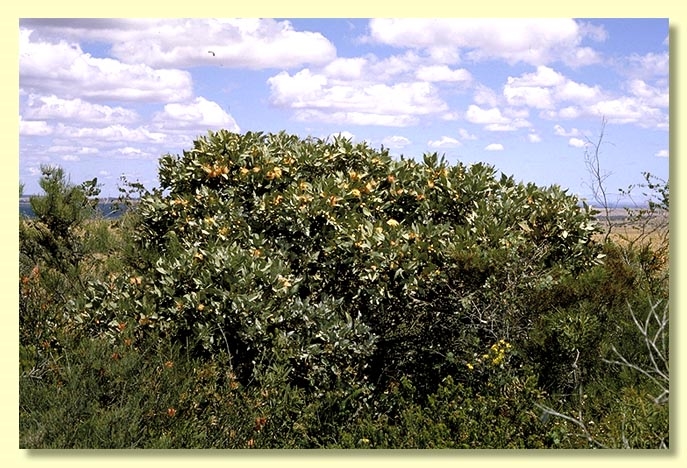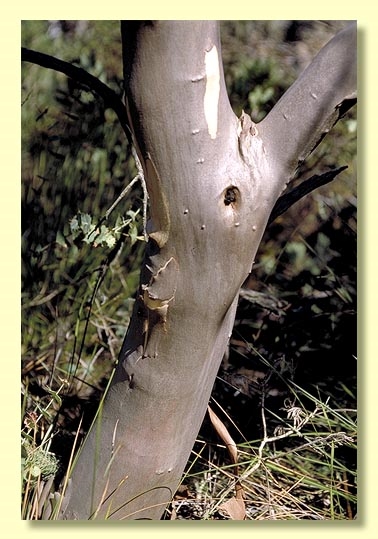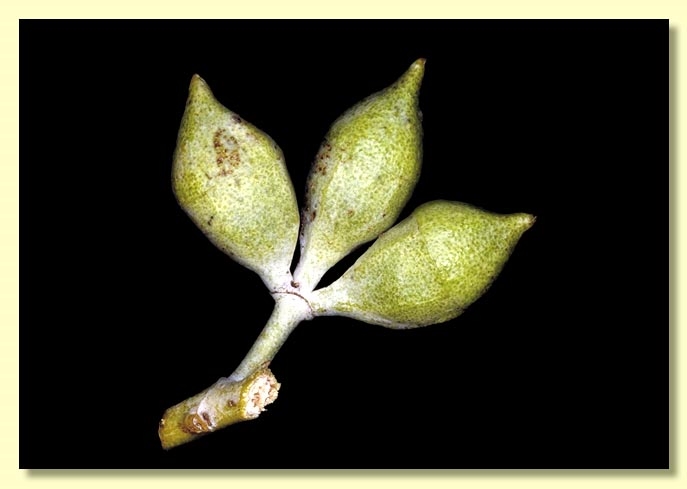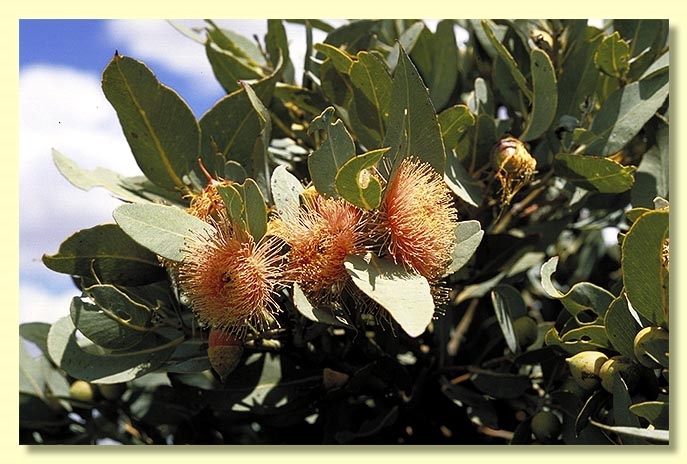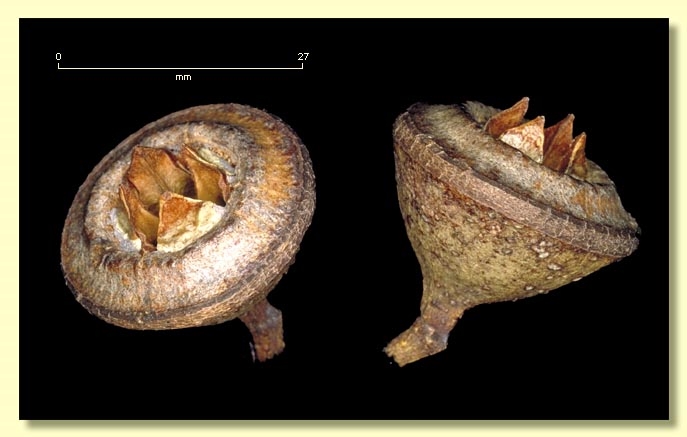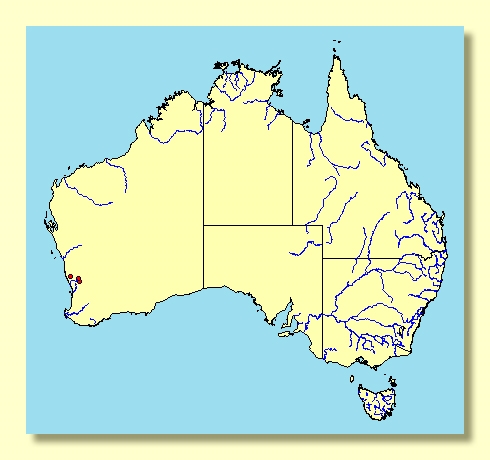Eucalyptus | Symphyomyrtus | Bisectae | Destitutae | Curviptera | Xylocarpae
Euclid - Online edition
Eucalyptus carnabyi
T: near Moora, W.A., Mar. 1937 & Apr. 1939, I.Carnaby & H.Steedman s.n. ; syn: whereabouts unknown; isosyn: PERTH.
Bark smooth throughout, whitish grey to grey or mottled with brown.
Branchlets lacking oil glands in the pith.
Juvenile growth (coppice or field seedlings to 50 cm): stems rounded in cross-section, slightly glaucous; juvenile leaves always petiolate, opposite for few nodes then becoming alternate, ovate to elliptical, 3–5.5 cm long, 2–3 cm wide, margin entire or subcrenulate, blue-green to glaucous.
Adult leaves sub-opposite to alternate, petiole 0–1.5 cm; blade broadly elliptical to ovate, 6–9.5 cm long, 2.5–5.5 cm wide, base tapering to petiole or rounded, margin entire, apex acute or less commonly rounded, lamina undulate or flat, dull, blue-green or slightly glaucous, side-veins usually greater than 45° to midrib or sometimes acute, reticulation dense, intramarginal vein present, oil glands intersectional.
Inflorescence axillary unbranched, peduncles 0.7–2 cm long, buds (1)3(7) per umbel, pedicels 0.5–0.8 cm long. Mature buds ovoid (2.2–3 cm long, 1.5–2.2 cm wide), glaucous, scar present, operculum conical or slightly beaked (1.5–1.8 cm long), outer stamens erect, inner stamens inflexed, anthers oblong, versatile, dorsifixed, dehiscing by longitudinal slits, style long and straight, stigma blunt, locules 4 or 5, the placentae each with 6 or 8 vertical rows of ovules or rows indistinct. Flowers pale yellow-pink.
Fruit sessile to shortly pedicellate (pedicels (0)0.2–0.5), cupular to broadly obconical, 1.2–1.8 cm long, 2.2–2.7 cm wide, disc broad, raised, concave, valves 4 or 5, strongly exserted.
Seeds brown to slightly grey-brown, 2–3.5 mm long, truncately pyramidal, sometimes flattened, always with some angles and faces, dorsal surface shallowly reticulate, a narrow and incomplete marginal flange sometimes present, hilum terminal.
Cultivated seedlings (measured at node 10): cotyledons Y-shaped (bisected); stems square to rounded in cross-section, glaucous or non-glaucous; leaves usually petiolate, opposite for at least 14 nodes or sub-opposite from ca node 10, elliptical to ovate, 4.5–8 cm long, 2.5–4.5 cm wide, base rounded to truncate or tapering, lamina undulate, glaucous.
Flowering has been recorded in June.
A rare mallee endemic to Western Australia, known from a few localities north-east of Perth in the northern wheatbelt, near Piawaning, Mullering Road, Dandaragan and north-east of Calingiri. E. carnabyi is distinguished by having sessile to shortly petiolate opposite leaves in the crown, pedicellate smooth ovoid buds usually in threes (though single buds and buds in sevens do occur), outer stamens erect in bud, fruits with a large conspicuous shallowly ascending disc and the seeds are flattened-pyramidal. The bark in E. carnabyi is smooth and the crown dense with leaves in the juvenile leaf phase, i.e. shortly petiolate, opposite to sub-opposite, ovate, dull, grey-green.
Eucalyptus carnabyi belongs in Eucalyptus subgenus Symphyomyrtus section Bisectae subsection Destitutae because buds have two opercula, cotyledons are Y-shaped and branchlets lack oil glands in the pith. Within this subsection E. carnabyi is in series Curviptera subseries Xylocarpae, one of about 17 closely related species and subspecies which are further characterised by having large buds in umbels of one, three or seven, staminal filaments erect or oblique (rarely inflexed) in bud, and large fruit usually with an ascending disc and exserted valves. Five of these species and subspecies are noted for their large-leaved crowns made up of juvenile leaves, viz. E. carnabyi, E. macrocarpa (two subspecies), E. impensa and E. rhodantha. All occur to the north and east of Perth on sandplain or in the wheatbelt. E. carnaby differs in having smaller fruit (up to 2.7 cm wide) than any of these and has yellow-pink flowers, not pink or red.

